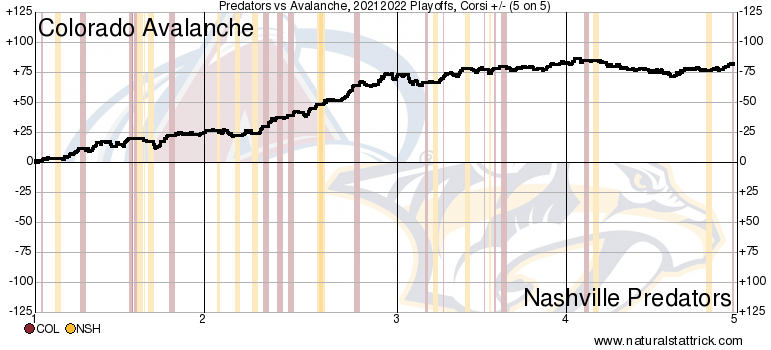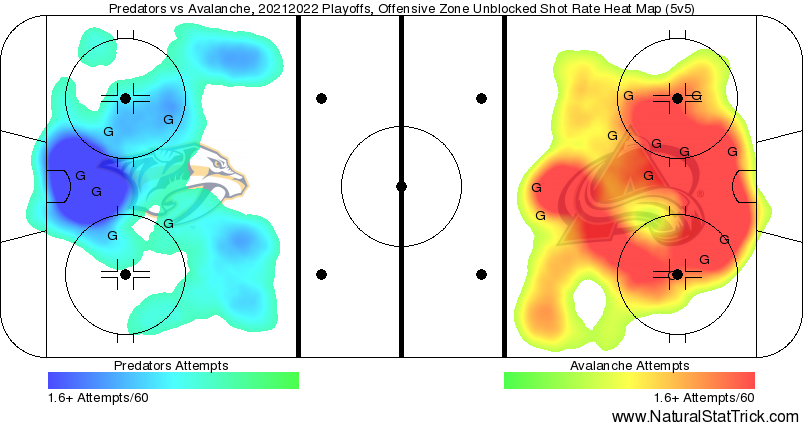© 2025 ALLCITY Network Inc.
All rights reserved.

Well, Calgary Flames head coach Darryl Sutter gave everyone an amusing soundbite when he mentioned being a wild card team would be “a waste of eight days.”
Turns out, the Avs only needed seven.
Upon getting their fourth sweep in Avalanche history and second in as many years, the Avs are off to the second round for the fourth consecutive season. It’s also the round Colorado has lost in each season of the last three years.
But that pain is for another day. Today, however, I want to get into what went right for the Avalanche over the Nashville Predators following their impressive sweep of what had been a record-setting Predators club (they broke a few notable franchise records this year).
Let’s get into some of the storylines that helped decide this tidy little series.
Goaltending. Always with the damn goalies.
Look, it’s just reality, okay? We have to talk about the guys who stop pucks. We’ve seen great teams foiled by all-time great goaltending performances (looking at you, 2010 Washington Capitals) and the guy who does all that heavy lifting gets remembered forever.
When Predators star goaltender Juuse Saros was ruled out before the start of the series (Preds head coach John Hynes tried to make a game of it, but Saros was never playing), it became arguably the dominant storyline coming in.
Saros had, by even the most aggressively negative standards, a top-10 season this year and was named as a Vezina Trophy finalist this morning. His absence was set to make a huge difference.
When Colorado scored five goals in the first period on veteran backup David Rittich, who had just beaten the Avs a week earlier in a shootout, it seemed to set the tone that no Saros meant no chance for Nashville.
Connor Ingram’s insertion into the series proved an important moment, however. He finished the series 0-3 with a .913 save percentage and the ultimate “what if?” experience of stopping 49 shots in Game 2 and still losing 2-1 because the team in front of him gave him absolutely zero help that night.
It wasn’t just Nashville’s netminders that became a story, however, as Darcy Kuemper missed essentially half the series after taking a stick to the eye area in the first period of Game 3. Kuemper finished with a .934 save percentage in 148 minutes played but did not return to action. His status going into Round 2 remains unknown (but it sounds like the situation is moving in a positive direction).
Pavel Francouz entered the series and was fine. He wasn’t spectacular as he gave up five goals in a little over five periods of play but really only the first goal he gave up in Game 3 is one he’d really want another chance to stop.
The other goals scored on Francouz were quality shots and quality plays from the Predators. Francouz simply needed to be just good enough and he was just that as Ingram imploded in Game 3 and then just didn’t have the special save in him for Game 4.
Francouz was steady, reliable, unspectacular. He didn’t play well enough to create any kind of drama or controversy, but he played well enough for everyone to have confidence he can keep the Avs competitive if he’s called upon again this postseason.
From starting the series with no Saros and Kuemper in net, it’s wild to think that Game 4 ended with a head-t0-head battle of Pavel Francouz vs. Connor Ingram.
No doubt Nashville missed Saros, but looking at how this series unfolded, it’s hard to make a strong argument that the Predators would have been significantly more competitive had Saros not suffered that injury at the end of the regular season.
The one thing that really went Nashville’s way was Ingram stepping into the spotlight and while he didn’t steal the show, he showed plenty enough to believe he belongs in the conversation for their roster next season.
Now, the team in front of Ingram…well, that team left plenty to be desired.
I love numbers, AJ. They tell such a vivid story. Hit me.
Well, if you insist.
Nashville’s goaltending held up decently enough following the Game 1 fiasco, but the rest of the team…not so much.
Here is the raw breakdown of the key metrics we always use, starting at 5v5.
- Corsi: 253-171 Colorado
- Shots on goal: 136-97 Colorado
- Goals: 12-6 Colorado
- Expected goals for: 10.03-6.78 Colorado
- Scoring chances: 121-72 Colorado
- High-danger chances: 43-33 Colorado
Okay, what about special teams? On the power play, those same numbers:
- Corsi: 48-21 Colorado
- Shots on goal: 25-10 Colorado
- Goals: 5-3 Colorado
- Expected goals for: 3.21-1.09 Colorado
- Scoring chances: 29-7 Colorado
- High-danger chances: 12-2 Colorado
This doesn’t include the success the Avs had on the penalty kill, in which they actually scored one short-handed goal, put seven shots on goal on five scoring chances and two high-danger chances.
As in, Colorado’s PK was a much better comparable to Nashville’s power play than what the Avs did in a 5v4 situation, which the Avs completely dominated.
I should note those PP numbers above are strictly 5v4, so Nashville’s 5-on-3 stretch and the Avs playing 5v5 on the power play at the end of Game 4 aren’t included in these numbers.
The takeaway here is pretty easy. Colorado’s territorial dominance was all-encompassing, thorough, undeniable. The Avalanche ran over the Nashville Predators and the resistance was not only futile but barely recognizable at all.
Here’s how the series looked in fancy chart form:


You see the steady climb there until Game 4 from that first chart? That’s Colorado simply dominating puck possession and shot attempts through three full games.
When you look at the second viz, you see the Predators had their greatest success right in front of Colorado’s net, but virtually zero success from anywhere else in the offensive zone.
Compare that to Colorado, who poured on shot attempts from all over the zone. They got goals from various locations, not relying on any one thing to get them goals.
If you’re looking for something to be worried about from Colorado’s side, it’s that Nashville did have that level of success around Colorado’s net. I won’t make too much of it because the Preds do have some good players and didn’t score many cheap goals throughout the series.
So we’ve gone through goaltending and taken a look at the numbers. I’ll turn the floor ever so briefly over to Micah Blake McCurdy, whose excellent work inspires a lot of the things I put into pieces like this.
Round 1, NSH 0 at COL 4
Avs dominated in shots at 5v5 and on special teams, and got better goaltending. Not close in any respect. pic.twitter.com/sMgVc2tiJz
— Micah Blake McCurdy (@IneffectiveMath) May 10, 2022
Well said, Micah.
The last matchup I wanted to look at was the battle between two of the three Norris Trophy finalists.
Fall of the Roman empire
Every year, Cale Makar has another challenger to the throne. First, Quinn Hughes came for the Calder Trophy and lost.
Then Adam Fox, he of the New York Rangers, leveraged a great season and his maximum exposure to snatch the Norris Trophy from Makar, and this year Josi turned a great year into a historic one following a legendary March that catapulted him ahead in the defensemen scoring race.
Will Josi topple Makar for the Norris this year? We don’t know yet and won’t know for a while, but every single voter who put Josi first on their ballot is already dreading the day their votes are revealed publicly because their head-to-head during the series left the hockey world with one undeniable truth: Roman Josi, while great, is no Cale Makar.
The final totals at the end of the series?
Makar: 3 goals, 7 assists, 10 points (most in NHL history by a defenseman through four postseason games)
Josi: 1 goal, 1 assist, front row seat to an ass-kicking he’ll never forget
To dig into the deeper numbers, it’s even worse.
At 5v5 in the series, here are their fancystats.
- Corsi: 109-67 Makar, 79-103 Josi
- Shots on goal: 65-39 Makar, 48-59 Josi
- Goals: 6-2 Makar, 1-3 Josi
- xGF%: 64.30 Makar, 39.87% Josi
- SCF: 60-29 Makar, 33-45 Josi
- HDCF: 22-13 Makar, 15-15 Josi
When they were on the ice together? Makar 51 CF, Josi 32. Most of that separation came in Game 2, but in no games did Josi break even in the head-to-head matchup against Makar. In the deeper head-to-head stats, Makar’s worst game in xGF% was Game 3 at 55.61%.
Needless to say, this was a bludgeoning. It’s a good thing the Norris Trophy is a regular-season award because an extra week’s worth of data would have taken it from a close race to a runaway for Makar.
Makar’s imprint on the series and case as the best player in the NHL through the first round dwarfed anything Josi could accomplish. While some might point to Josi having to do heavier lifting because his team is significantly worse, I’d say that the most clear-cut disparity between the two teams showed in each of their best players.
Makar showed up and relentlessly drove Colorado to dominance and Josi got a front-row seat to Makar taking the throne as the league’s best all-around defenseman.
Like the Avs in this series, Makar left no doubt.
Balanced scoring
This will be quick, but I thought it was noteworthy. Obviously in scoring 21 goals across four games, there’s plenty of production to speak of, but Makar was the only one to really separate.
Makar’s 10 points were four more than anyone else as Nathan MacKinnon and Gabe Landeskog each racked up six points apiece. While he didn’t score a goal during the series, Mikko Rantanen had five assists but recorded zero points in both Games 2 and 4. Devon Toews locked down the other half of Colorado’s top d-pairing with five points of his own.
Going down Colorado’s lineup, they got multiple points from 12 players and at least one point from 16 of the 19 skaters to appear for the Avs in the series. Logan O’Connor, Nicolas Aube-Kubel, and Darren Helm were the only players not to record points.
That’s going to be a tough trick to replicate in Round 2, but this was the kind of down-lineup scoring Joe Sakic envisioned when he gave up major assets at the trade deadline to put together arguably Colorado’s most talented forward corps top-to-bottom since 2002.
Bring on the Blues. Or let’s get Wild. Whatever.
Comments
Share your thoughts
Join the conversation



